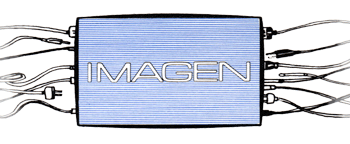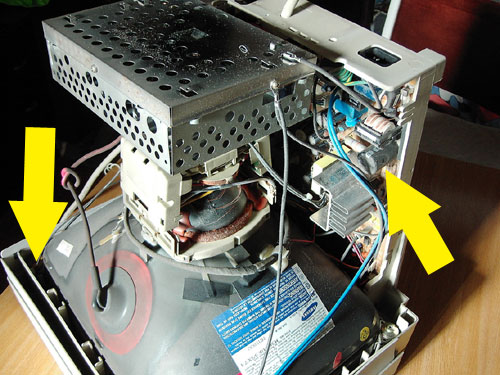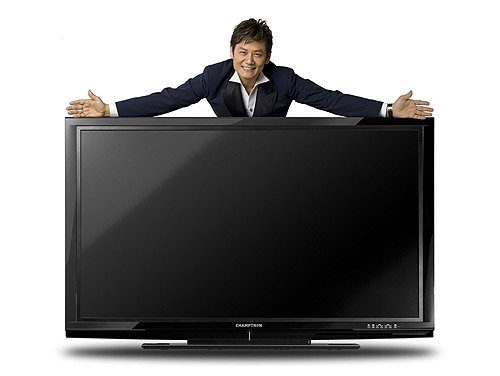 |
|
 |
|
|
|
A video on the web might just be a bunch of pictures shown one after the other, but SDI is a video signal that is meant to be switched, cut-to in progress, etc. It is not like a computer file, and we still might have to convert the signal for Grandma's TV set, so we retain the old "blanking" periods of the Analog signal. These represent almost 20% of the time per frame. At Standard Definition bit rate of 270 million bits per second, this leaves over 50 million bits per second that we can use for other stuff. The old blanking periods are now called "HANC" and "VANC"... pronounced just like they look. The H & V are for horizontal and vertical. The "ANC" portion is for Ancillary Data. |
Carried along with the picture:
It's very handy to have the audio on the same signal as the video. It simplifies routing and patching, but some studio equipment doesn't pass the audio, most notably the production switcher. |
 |
We used to watch television on Cathode Ray Tubes, aka
CRT's aka Picture Tubes.
This is a picture of a computer monitor lying on it's face. The left-hand arrow points to the bezel that frames the edges. We were never sure how much of the picture was behind the bezel, which led us to invent SAFE AREA and SAFE TITLE limits. The right-hand arrow points to a 1000 micro-farad capacitor in the vertical deflection circuit that was the component that added ten pounds to people as it aged and let the picture shrink vertically. |
 |
Flat panel displays went through some problems, mostly
when the image wasn't being viewed straight-on. Those days have passed,
and today's panels have excellent colour, and decent contrast. Aging
components don't change the picture geometry, and we get to see the
entire image, so no "safe-area" is necessary.
With stable geometry, if you look 10 pounds heavier on one of these, you should consider eating less. |
|
|
| The word "Digital" simply means numeric. It is generally taken to mean the binary system, which is number-base two. It has two digits... one and zero. This can be stored as holes in paper, or represented as any voltage versus the absence of that voltage. The beauty of a number system with only two digits is that you can still recognize the digits even after much degradation. That's why digital TV is always perfect, until it disappears completely! |
|
1000's |
100's |
10's |
1's |
Number |
|
1 |
2 |
3 |
4 |
1,234 |
| There is nothing particularly interesting here, because we all know base ten. Note that there are ten digits available (0-9) and that the highest digit is one less than the number base. The three in the ten's place is thirty... three tens, and so on. The number places go "up" in powers of the number base. |
|
128's |
64's |
32's |
16's |
8's |
4's |
2's |
1's |
Decimal |
| 1 |
0 |
0 | 1 | 0 | 0 | 1 | 1 |
147 |
| Well, it just doesn't look the same... but it follows the
same rules. Base Two has two digits 0-1, and the highest digit is one
less than the number base. Number places go "up" in powers of
the number base. This eight BIT number can only count up to 255. That's
2 raised to the power of eight, minus one, because zero is one of the
numbers (0-255 is 256 numbers). By the way, "BIT" is a
contraction of "Binary Digit".
Binary numbers are very HARD TO READ... |
|
16's |
1's |
Decimal |
| 8 | 0 | 128 |
| D | 9 | 217 |
| 6 | F | 111 |
| A | 7 | ??? |
| It's the same! No, really. Base 16 (Hexadecimal, or
"Hex") follows the same rules. There are 16 digits
0,1,2,3,4,5,6,7,8,9,A,B,C,D,E,F. A is worth ten, B is worth eleven, up
to F is worth 15... one less than the number base. A two digit Hex
number can go as high as 255, which would be oxFF, or fifteen sixteens
plus 15. Hex numbers are always preceeded by something like
"$" or "ox" to distinguish them as hex, because
"80" could be decimal eighty, or Hex 80, which is equal to
decimal 128.
The "places" in hex go "up" in sixteen, so a third place would be the "256's", and a fourth would be the "4,096's" The highest number in four places is oxFFFF... 65,535 in decimal. |
|
|
You will never have to work in Base Two, and will seldom work in Hexadecimal, but Windows ™ Calculator can be set to work, and convert back and forth. See the options under "View". |
| 10011010111010001110110101110110100101110101001111010001111010101111101110 |
| So, what the hell is THAT? Just to clear up a mystery
that hasn't occurred to you yet, how does a machine make sense of a
stream of ones and zeros flying at it at 270 million bits per second?
That's standard-def. In hi-def that's 1.5 BILLION bits per second.
Well, you insert a specific pattern of bits that is not too likely to occur naturally every so often, let's say every 172 bytes. Once you see the pattern, look for it again 171 bytes later. If you keep getting it at 172 byte intervals, you are in sync with the bytes. Since you know how big the bytes are, and how often to look for the sync code, What can go wrong? |
| I have used eight bit bytes throughout to keep things manageable. SDI video uses 10 bit bytes... a total of two to the power of ten, or 1024 levels. If I had used ten bit examples, I couldn't have called them "Bytes", Other bit sizes are "Words", so we really use ten bit words, giving 1024 levels. In SDI, white and black are not "1023" and Zero, rather there is some space for video above 100%, and below black. (White is 940, and black is at 64)(That's 0x40 and 0x3AC), doncha know) |